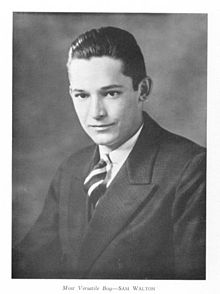Sam Walton
From Wikipedia, the free encyclopedia
| Sam Walton | |
|---|---|

Sam, as he appears in David H. Hickman High School's yearbook
| |
| Born | Samuel Moore Walton March 29, 1918 Kingfisher, Oklahoma, U.S. |
| Died | April 5, 1992 (aged 74) Little Rock, Arkansas, U.S. |
| Nationality | American |
| Alma mater | University of Missouri 1940 |
| Occupation | Founder of Walmart |
| Net worth | |
| Religion | Presbyterianism[2] |
| Spouse(s) | Helen Walton (1943 – his death) |
| Children | 4 |
Samuel Moore "Sam" Walton (March 29, 1918 – April 5, 1992) was an American businessman and entrepreneur born inKingfisher, Oklahoma, best known for founding the retailersWalmart and Sam's Club.
Contents
[hide]Early life
Sam Walton was born to Thomas Gibson Walton and Nancy Lee, in Kingfisher, Oklahoma. There, he lived with his parents on their farm until 1923. Sam's father decided farming did not generate enough income on which to raise a family and decided to go back to a previous profession of farm mortgaging[3] where he repossessed farms during the Great Depression.[4]
He and his family (now with another son, James, born in 1921) moved from Oklahoma to Orlando, Florida. There they moved from one small town to another for several years. While attending eighth grade in Shelbina, Missouri, Sam became the youngest Eagle Scout in the state's history.[5] In adult life, Walton became a recipient of the Distinguished Eagle Scout Award from the Boy Scouts of America.[6]
Eventually the family moved to Columbia, Missouri. Growing up during the Great Depression, Walton had numerous chores to help make financial ends meet for his family as was common at the time. He milked the family cow, bottled the surplus, and drove it to customers. Afterwards, he would deliver Columbia Daily Tribunenewspapers on a paper route. In addition, he also sold magazine subscriptions.[7] Upon graduating from David H. Hickman High School in Columbia, he was voted "Most Versatile Boy".
After high school, Walton decided to attend college, hoping to find a better way to help support his family. He attended the University of Missouri as a ROTC cadet. During this time, he worked various odd jobs, including waiting tables in exchange for meals. Also during his time in college, Walton joined the Zeta Phi chapter of Beta Theta Pi fraternity. He was also tapped by QEBH, the well-known secret society on campus honoring the top senior men, and the national military honor society Scabbard and Blade. Upon graduating in 1940 with a Bachelor's of Economics, he was voted "permanent president" of the class.[8]
Walton joined J.C. Penney as a management trainee in Des Moines, Iowa[8] three days after graduating from college.[7] This position paid him $75 a month. He resigned in 1942 in anticipation of being inducted into the military for service in World War II.[7] In the meantime, he worked at a DuPont munitions plant near Tulsa, Oklahoma. Soon afterwards, Walton joined the military in the U.S. Army Intelligence Corps, supervising security at aircraft plants and prisoner of war camps. In this position he served at Fort Douglas in Salt Lake City, Utah. He eventually reached the rank of Captain.
The first stores
In 1945, after leaving the military, Walton took over management of his first variety store at the age of 26. With the help of a $20,000 loan from his father-in-law, plus $5,000 he had saved from his time in the Army, Walton purchased a Ben Franklin variety store in Newport, Arkansas.[7] The store was a franchise of the Butler Brotherschain.
Walton pioneered many concepts that became crucial to his success. Walton made sure the shelves were consistently stocked with a wide range of goods. His second store, the tiny "Eagle" department store, was down the street from his first Ben Franklin and next door to its main competitor in Newport. Walton leased the space mainly to preempt his competitor from expanding. It held its own, but didn't fare as well.[citation needed]
With the sales volume growing from $80,000 to $225,000 in three years, Walton drew the attention of the landlord, P.K. Holmes, whose family had a history in retail.[1] Admiring Sam's great success, and desiring to reclaim the store (and franchise rights) for his son, he refused to renew the lease. The lack of a renewal option, together with the prohibitively high rent of 5% of sales, were early business lessons to Walton. Despite forcing Walton out, Holmes bought the store's inventory and fixtures for $50,000, which Walton called "a fair price".[9]
With a year left on the lease, but the store effectively sold, he, his wife Helen and his father managed to negotiate the purchase of a new location on the downtown square of Bentonville, Arkansas. Walton negotiated the purchase of a small store, and the title to the building, on the condition that he get a 99-year lease to expand into the shop next door. The owner of the shop next door refused 6 times, and Walton gave up on Bentonville when his father-in-law, without Sam's knowledge, paid the shop owner a final visit and $20,000 to secure the lease. He had just enough left from the sale of the first store to close the deal, and reimburse Helen's father. They opened for business with a one-day remodeling sale on May 9, 1950.[1]
Before he bought the Bentonville store, it was doing $72,000 in sales and it increased to $105,000 in the first year and then $140,000 and $175,000.[10]
A Chain of Ben Franklin Stores
With the new Bentonville "Five and Dime" opening for business, and 220 miles away, a year left on the lease in Newport, the cash-strapped young Walton had to learn to delegate responsibility.[11][12]
After succeeding with two stores at such a distance (and with the post war baby boom in full effect), Sam became enthusiastic about scouting more locations and opening more Ben Franklin franchises. (Also, having spent countless hours behind the wheel, and with his close brother James "Bud" Walton having been a pilot in the war, he decided to buy a small second-hand air-plane. Both he and his son John would later become accomplished pilots and log thousands of hours scouting locations and expanding the family business.)[11]
In 1954, he opened a store with his brother Bud in a shopping center in Ruskin Heights, a suburb of Kansas City, Missouri. With the help of his brother, father-in-law, and brother-in-law, Sam went on to open many new variety stores. He encouraged his managers to invest and take an equity stake in the business, often as much as $1000 in their store, or the next outlet to open. (This motivated the managers to sharpen their managerial skills and take ownership over their role in the enterprise.)[11] By 1962, along with his brother Bud, he owned 16 stores in Arkansas, Missouri, and Kansas (fifteen Ben Franklins and one independent, in Fayetteville).[citation needed]
The first Wal-Mart
Main article: History of Wal-Mart
The first true Wal-Mart opened on July 2, 1962 in Rogers, Arkansas.[13] It was called the Wal-Mart Discount City store and located at 719 West Walnut Street. Soon after, the Walton brothers teamed up with the Stefan Dasbach, leading to the first of many stores to come. He launched a determined effort to market American-made products. Included in the effort was a willingness to find American manufacturers who could supply merchandise for the entire Wal-Mart chain at a price low enough to meet the foreign competition.[14]
As another chain store grew, Meijer, it caught the attention of Walton. He acknowledges that his one-stop-shopping center format was based on Meijer’s innovative concept.[15] Contrary to the prevailing practice of American discount store chains, Walton located stores in smaller towns, not larger cities. To make his model work, he emphasized logistics, particularly locating stores within a day's drive proximity to Wal-Mart's regional warehouses, and distributed through its own trucking service. Buying in volume and efficient delivery permitted sale of discounted name brand merchandise. Thus, sustained growth— from 1977's 190 stores to 1985's 800— was achieved.[8]
Personal life
| This section requires expansion.(September 2009) |
Walton married Helen Robson on February 14, 1943.[7] They had four children: Samuel Robson (Rob) born in 1944, John Thomas (1946-2005), James Carr (Jim) born in 1948, and Alice Louise born in 1949.[16] Walton supported various charitable causes.
Death
Walton died on Sunday, April 5, 1992, of multiple myeloma, a type of blood cancer, in Little Rock, Arkansas.[17]The news of his death was relayed by satellite to all 1,960 Wal-Mart stores.[18] At the time, his company employed 380,000 people. Annual sales of nearly $50 billion flowed from 1,735 Wal-Marts, 212 Sam’s Clubs, and 13 Supercenters.[8]
His remains are interred at the Bentonville Cemetery.[19]
He left his ownership in Wal-Mart to his wife and their children: Rob Walton succeeded his father as theChairman of the Board of Wal-Mart, and John Walton was a director until his death in a 2005 plane crash. The others are not directly involved in the company (except through their voting power as shareholders), however his son Jim is chairman of Arvest Bank. The Walton family held five spots in the top ten richest people in the United States until 2005. Two daughters of Sam's brother Bud Walton, Ann Kroenke and Nancy Laurie, hold smaller shares in the company.
Legacy
In 1998, Walton was included in Time's list of 100 most influential people of the 20th Century.[20] Walton was honored for all his pioneering efforts in retail in March 1992, when he received thePresidential Medal of Freedom from President George H. W. Bush.[18]
Forbes ranked Sam Walton as the richest person in the United States from 1982 to 1988, ceding the top spot to John Kluge in 1989 when the editors began to credit Walton's fortune jointly to him and his four children.[citation needed] (Bill Gates first headed the list in 1992, the year Walton died). Wal-Mart Stores, Inc. also runsSam's Club warehouse stores. Walmart operates in the U.S. and in 15 international markets, including Argentina, Brazil, Canada, Chile, China, Costa Rica, El Salvador, Guatemala, Honduras, India, Japan, Mexico, Nicaragua and the United Kingdom.[21]
At the University of Arkansas, the Business College (Sam M. Walton College of Business) is named in his honor. Walton was inducted into the Junior Achievement U.S. Business Hall of Fame in 1992.



No comments:
Post a Comment